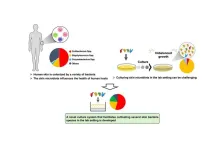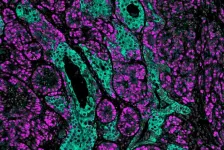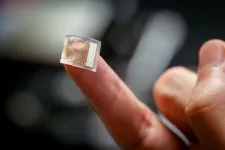Researchers eliminate the gritty mouth feel: How to make it easier to eat fiber-rich foods
2024-11-20
(Press-News.org)
Fiber is something that most of us get far too little of. To change that, we need to actually enjoy eating it. Food researchers from the University of Copenhagen have now invented a "disguise" that solves the problem of the dry and gritty mouth feel of fibers.
Think of how it would be to drink a juice with wheat bran in it – you may imagine an unpleasant gritty sensation which would make you less prone to enjoy it.
Unfortunately, this feeling is often associated with insoluble dietary fibers. Those are the kind of fibers found in e.g. wheat bran, vegetables, and whole grains. The unfortunate feeling is a problem as the majority of the world’s population doesn’t consume enough fibers, which are crucial for our bodies. This negatively affects human health in several ways. For example, fibers help prevent cardiovascular diseases, diabetes, and colon cancer. In fact, a lack of fiber intake leads to roughly one million deaths annually.
“If we don't like it, we don't eat it. It's that simple. And no one would enjoy eating grainy flour – but that's roughly what the sensation of insoluble dietary fibers often produces, especially added to more liquid foods like yogurt, juices and beverages,” says Professor Lilia Ahrné of the University of Copenhagen’s Department of Food Science.
While insoluble fibers work well in breads, there are many other types of products where this isn’t the case. This is due to the dry (similar to the sensation known from red wine and green tea) and grainy-like feeling in the mouth that most people find unappetizing.
“This is why there is such a limited selection of fiber-rich foods and beverages. And that’s why it’s important to figure out how to incorporate fibers into more foods without causing a bad eating experience. The more variety there is in fiber-rich products, the greater the likelihood that people will increase their fiber intake. And now, we have a potential solution,” says Lilia Ahrné.
From rough to velvet
Ahrné and a team of research colleagues from both Denmark and other countries have developed a way to 'disguise' fibers, by making them – quite literally – more palatable.
Inspired by foods like chia seeds, which are naturally enveloped in a soft, gel-like layer, the researchers encapsulated pea cell-wall fibers in a gel that forms a soft coating around the fiber particles.
“The gel coating makes the fibers feel velvety, like cream on the tongue, where you can't feel the individual particles because the gel prevents contact between the particles and the tongue. Since the gel is at least as soft as tongue tissue, it doesn’t trigger the sensory receptors, and we don’t perceive the gritty texture,” explains Gabriele D’Oria, former PhD student at the Department of Food Science, now postdoctoral researcher at INRAE - Université Paris-Saclay and first author of the research article on the study.
The gel-coated particles were put to the test with a trained tasting panel, where the results demonstrated that the test subjects perceived up to 52% less fibers, while the gel reduced the sensation of grittiness by 42% and dryness in the mouth by 36%.
“We have now demonstrated that gel coating works. The gel can be refined and adjusted depending on the purpose. And in principle, the method can be used for all types of foods and beverages,” says Gabriele D’Oria.
The gel is both flavor- and odor-free and is based on gellan gum, which is produced by bacteria and already deployed in the production of foods for other purposes. Furthermore, the process is also quick and simple.
“In lab trials, it took me seven minutes to produce thousands of coated fiber particles. And this can definitely be upscaled once operating on a larger scale. One could imagine giant silos producing tons of coated fiber particles,” says Gabriele D’Oria.
Beneficial for elder health – and climate
In the long run, the researchers hope that the idea could help solve an increasingly widespread health dilemma:
“We are dealing with a global nutritional issue that will only grow as the world’s population ages. Elderly people who consume too little fiber are more prone to, among other things, digestive issues, unintended weight loss and general frailty. Therefore, there will be a need to develop fiber-rich products that people actually want to eat,” says Lilia Ahrné.
The researchers believe that it makes sense to use gel coating in liquid foods like juice and drinkable yogurt.
Furthermore, the camouflaged fibers have the potential to become a climate-friendly diet option, as Ahrné points out:
“We are all aware of the need to shift to more plant-based diets. If we can understand how to address the negative experiences of eating dietary fibers, we can better utilize fiber-rich by-products, such as bran from grains, in a sustainable way.”
WE EAT TOO LITTLE FIBER
• In its Official Dietary Guidelines, the Danish Veterinary and Food Administration recommends that people consume at least 75 grams of whole grains per day. In 2019, 56% of the Danish population met this recommendation.
• A major study from 2017 shows that out of the 11 million people who died that year due to nutritional factors, low whole grain intake accounted for one million of the deaths (source: Health effects of dietary risks in 195 countries, 1990–2017: a systematic analysis for the Global Burden of Disease Study 2017 - ScienceDirect).
• The study, which covers 195 countries, also shows that on average, fiber intake was below 25 grams per day in all regions.
ABOUT THE STUDY
• The research article about the study has been published in the journal Food Hydrocolloids.
• The project has received support from Nestlé.
END
[Attachments] See images for this press release:
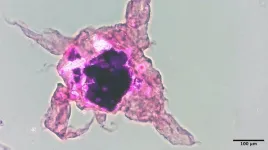
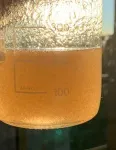
ELSE PRESS RELEASES FROM THIS DATE:
2024-11-20
Antibacterial drugs are important for treating infections. But increasingly, bacterial resistance to current drugs — so they don’t work well, or even at all — means new ones are urgently needed. Building on previous work, researchers in ACS Infectious Diseases have demonstrated a potential antibacterial treatment from a modified darobactin, a compound originally from a bacterium. The team reports proof-of-concept animal trials on infections caused by bacteria, including E. coli, that are known to develop drug resistance.
This study was published during the World Health Organization’s World Antimicrobial Resistance (AMR) Awareness ...
2024-11-20
Residential garden produce grown near the Fayetteville Works fluorochemical plant can expose those who consume it to per- and polyfluoroalkyl substances (PFAS), according to a new study conducted by researchers from North Carolina State University, East Carolina University and the Colorado School of Mines.
“It is often assumed that contaminated drinking water is the main pathway through which we are exposed to PFAS,” says Detlef Knappe, professor of civil, construction, and environmental engineering at NC State and a lead investigator of the study. “An important goal of our study was to determine whether people ...
2024-11-20
Carnegie Mellon University Africa announced today that it will expand its digital public infrastructure initiative across the continent. Called the Upanzi Network, this Africa-based collaboration of engineering research labs will work toward a secure and resilient digital transformation by focusing on innovation across the entire pipeline of open standard technologies for the public good.
The initiative was launched in 2021 with the creation of a research laboratory at CMU-Africa in Kigali, Rwanda. Since its launch, the laboratory has made progress in capacity building, knowledge transfer, and digital public infrastructure governance and deployment. It performs research in ...
2024-11-20
With most donated clothes exported or thrown away, experts are calling for a shakeup of how we deal with the growing fashion waste issue.
A first of its kind study, published in Nature Cities, analysed what happens to clothes and other textiles after consumers no longer want them in Amsterdam, Austin, Berlin, Geneva, Luxembourg, Manchester, Melbourne, Oslo and Toronto.
Across most western cities from Melbourne to Manchester it found the same pattern of textile waste being exported, going to landfill or being dumped in the environment.
Global textiles waste each year weighs 92 million tonnes and this could double by 2030.
Charity shops handle a large amount of used clothes, but the study ...
2024-11-20
The human skin is home to a wide variety of bacteria. The composition of the community of bacteria—called the “skin microbiota”—has serious implications for skin health. A healthy balance between different species of bacteria on the skin often translates to healthy skin. The loss of this balanced skin microbiota can lead to diseases such as atopic dermatitis, acne, and psoriasis. Since the skin microbiota can vary based on various factors such as age, sex, climate, and an individual’s ...
2024-11-20
As populations age, the prevalence of sarcopenia—a progressive loss of muscle mass and function—has become an increasingly urgent public health concern. Sarcopenia increases the risk of falls and frailty, reduces the quality of life for older adults, and heightens the likelihood of requiring long-term care. Preventing sarcopenia is, therefore, crucial for alleviating this healthcare burden.
A pioneering study conducted by researchers from Juntendo University in Japan sheds light ...
2024-11-20
An enzyme called EZH2 has an unexpected role in driving aggressive tumor growth in treatment-resistant prostate cancers, according to a new study by scientists at Weill Cornell Medicine. The results could potentially lead to new therapies for patients with limited options and add to the significant progress the teams have made in understanding how advanced prostate cancer develops resistance to treatments that target androgen receptors.
Prostate cancer is a leading cause of cancer-related death in men, claiming over 30,000 lives annually in the United States. While most prostate cancers initially respond ...
2024-11-20
CHICAGO – Nov. 20, 2024 – Northwestern Medicine, West Health, and the Meadows Mental Health Policy Institute have announced a new collaboration that will make accessing care to evidence-based mental health services faster and easier for primary care patients across Northwestern Medicine.
This $8.6 million multi-year initiative from West Health will establish the Northwestern Medicine West Health Accelerator, which will provide access to comprehensive psychiatric services for primary care practices throughout Northwestern Medicine, expanding access to mental health ...
2024-11-20
This research introduces a novel method for inferring DNA methylation patterns in non-skeletal tissues from ancient specimens, providing new insights into human evolution. As DNA methylation is a key marker of gene expression, this work allows scientists to explore changes in gene activity in the brain and other tissues that are typically absent from the fossil record. The team applied their method to the brain, offering a deeper understanding of the evolutionary processes that shaped human brain and neural functions. The findings ...
2024-11-20
A team of researchers at the University of California San Diego has developed a new and improved wearable ultrasound patch for continuous and noninvasive blood pressure monitoring. Their work marks a major milestone, as the device is the first wearable ultrasound blood pressure sensor to undergo rigorous and comprehensive clinical validation on over 100 patients.
The technology, published on Nov. 20 in Nature Biomedical Engineering, has the potential to improve the quality of cardiovascular health monitoring in the clinic ...
LAST 30 PRESS RELEASES:
[Press-News.org] Researchers eliminate the gritty mouth feel: How to make it easier to eat fiber-rich foods



